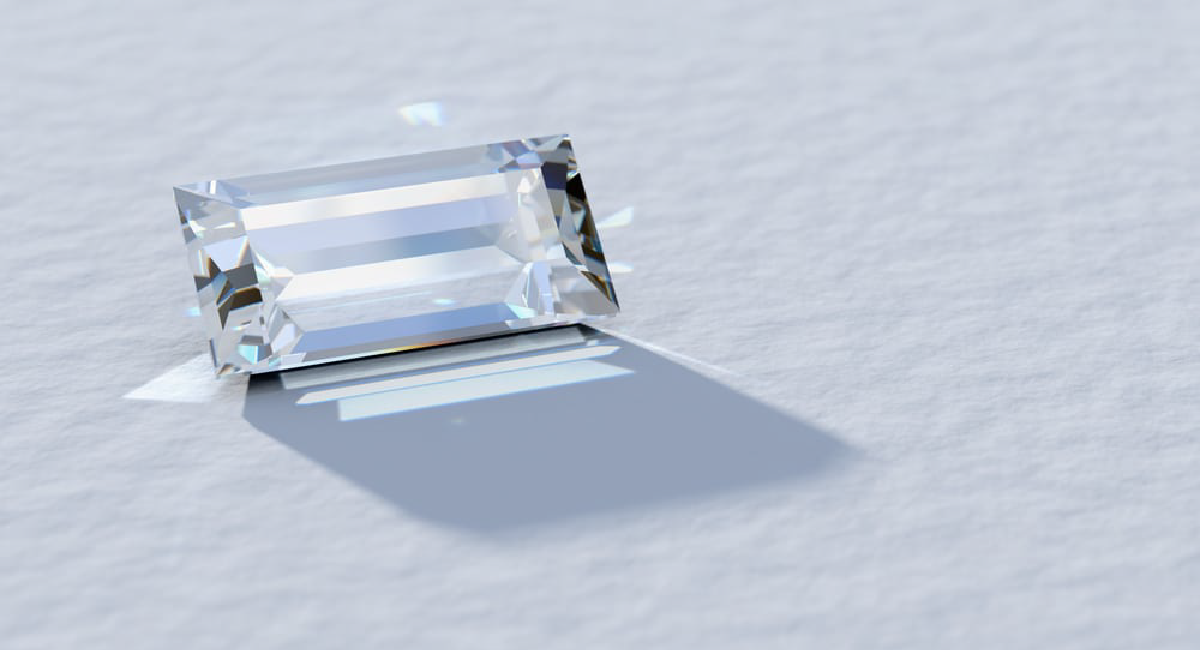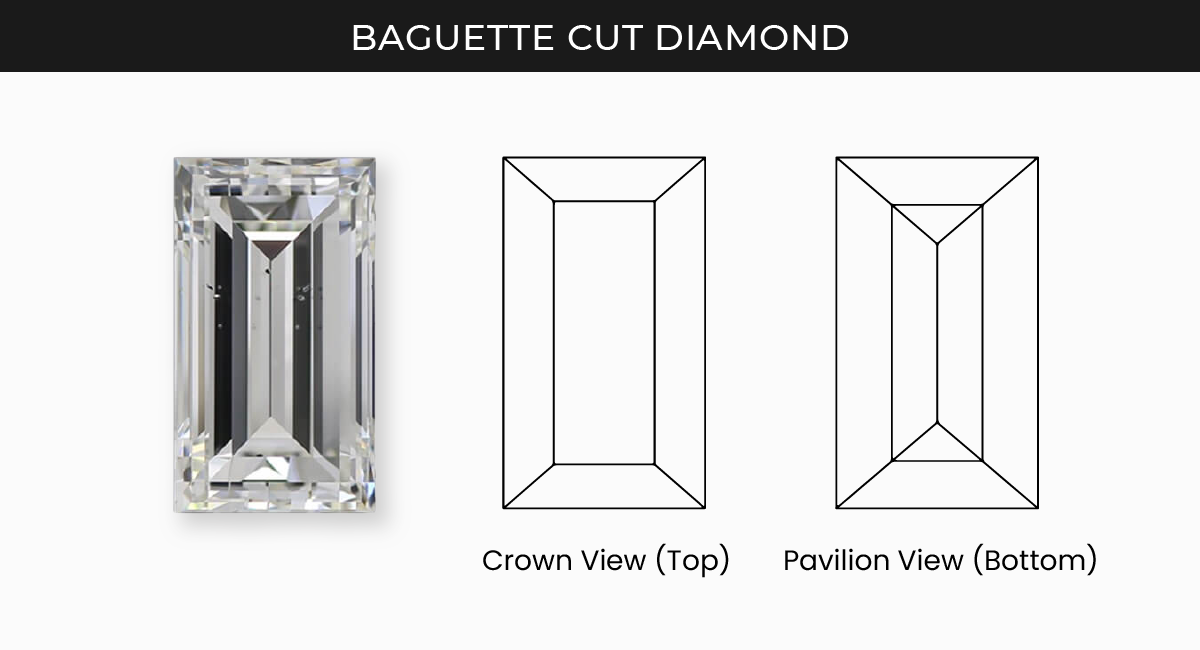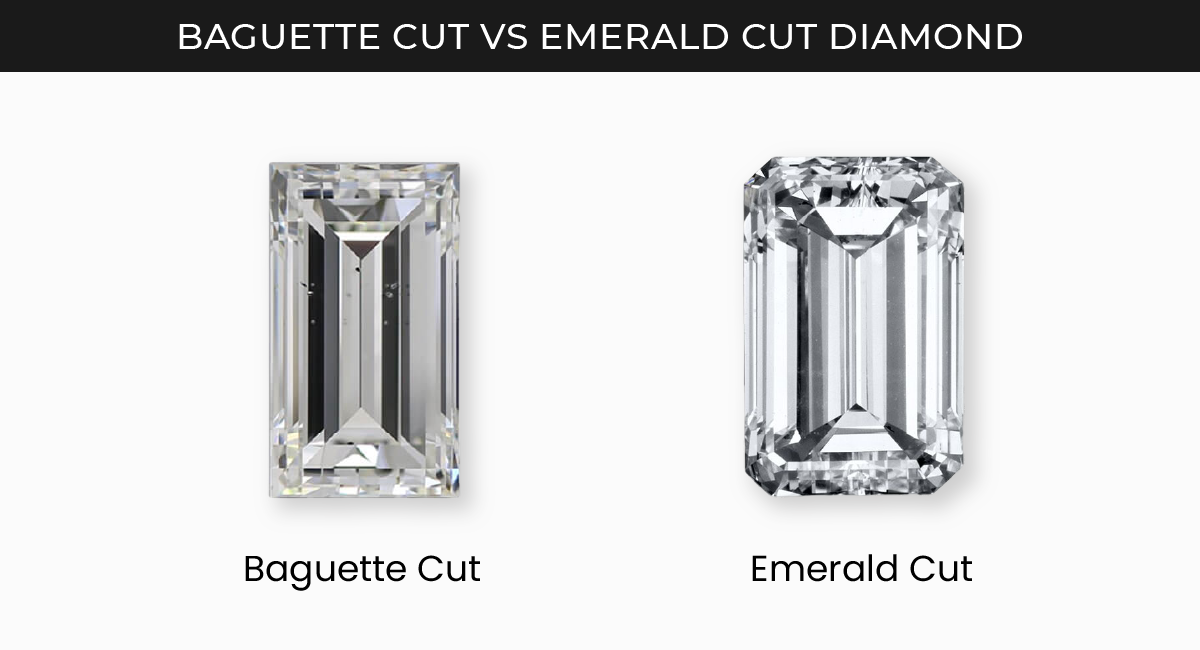Baguette Cut Diamond: In-Depth Analysis of a Fragile Cut
The baguette cut diamond is an oblong and slender diamond with particularly 14 iterative columns. This gem has its roots placed in the ‘step-cut’ lineage which tends to have a unique square-shaped parallel facet arrangement. Unlike the other members of this hierarchy such as the asscher cuts that have X-shaped facets, baguettes have straight or tapered edges.

The baguette is a type of accent diamond that when paired with relatively larger diamonds helps in enhancing their magnificence. A somewhat similar effect as that of melee diamonds is the beautification of the main stone by the presence of the side stones. On account of their length, they can easily fit into even the tiniest of bands. These stones have a peculiar yet important function in wedding rings as they can be put together with round brilliant cuts and enhance their radiant shimmer.
To give you a perspective of these rectangular shaped elongated diamonds. Thus they are super slim yet equally long and look quite nice when available in abundance.
What is a Baguette Diamond?
A baguette diamond refers to both the cut and shape of the diamond. For a diamond to be considered a baguette, it must be thin and elongated in a rectangular shape, usually with a length-to-width ratio of around 3:1.
Belonging to the step-cut family, which includes emerald and asscher cuts, baguette diamonds stand out with perfectly square corners. They typically have 14 straight-line cuts, offering exceptional clarity with a subtle sparkle, making them an ideal choice for accentuating other stones in a ring.

Pros
- Baguette diamonds are more inexpensive and affordable than brilliant cuts.
- Baguettes act as great side stones when put together with brilliant cuts and allow for the center stone to shine.
- Baguettes can be placed in various alignments and therefore make very versatile components of jewelry.
Cons
- They are not suitable for solitaires or jewelry where they have to be mounted alone.
- Due to their special arrangement inclusions are highly visible.
- They sparkle less than brilliant cut diamonds and thus might not be the optimal choice.
History of the Baguette Diamond
The term ‘baguette’ means a loaf of bread in French to which the diamond’s name can be attributed to its length. The discovery of this cut dates back over a hundred years during the Art Deco and Art Nouveau era. The Art Deco jewelry marks contrasting structural variations using baguette diamonds in various colors.

Art Nouveau jewelry has aesthetics with varied shapes and designs encompassing the baguette rings symbolizing femininity, grace, and culture. The uprising of baguette cuts signaled modernity and vogue in the contemporary world.
Originally baguette diamonds were used in crests and beautiful rings with the owner’s initials but over time, their use has evolved. Now they are used as insignias and brooches as well. The baguette diamond cut is a relic in the fashion world but it won’t be going out of fashion anytime soon.
What to Look for in Baguette Cut Diamond
Cut
The lab baguette cut diamond in general is made with fewer cuts in comparison to other lab grown diamond cuts. When you measure the facets in a baguette cut stone, that is the flat space in the diamond stone, there are only 14 facets. All of this naturally points down to the fact that any work done on the stone needs precision.

Why does this precision mean so much? It is because other stones that have more facets cover up the unevenness or lack of clarity but that doesn’t happen in the case of a baguette diamond due to the lower number of facets.
There are two main cuts of baguette diamond that you’d find, one is ‘tapered cut’ and another is ‘straight cut’. The straight-cut diamonds are complete rectangles with the sides opposite each other being perfectly parallel. The tapered ones, on the other hand, inherently look like trapezoidal stones with an angle leaning inwards.
You can choose between the two cuts which one suits you the best.
Clarity
Looking for absolute clarity in your baguette stone? The key is to look for detailed cuts and then you’ll attain a level of crystal clear clarity. That is fairly important as the facets and the cut of the stone will make sure whether or not the diamond will have the perfect clarity and shine you have been looking for.
What will affect the crystal clarity of your baguette stone? That would be a lack of brilliance in your diamond, which would also be visible to the world. This is due to the fact that any kind of incorporation or flaws present in the diamond are readily visible in the baguette stone because of its cut.
Hence a purchase of a high-quality grade baguette diamond that could be a VS2 clarity would make more sense in terms of an investment.
Carat
The carat size in your baguette shaped diamond is something important but can be looked out for at the end of the deal, focusing on clarity and color is very important. Hence, 0.5 to 1 carat baguette diamond should be your ideal choice range. You can check out Loose Grown Diamond’s specialized diamond size chart guide for measuring diamond sizes.
Color
How you choose the lab created baguette shaped diamond depends a lot on its color. Due to the shape and big facets they possess, they tend to show the true color of a diamond much better than diamonds that go through similar precise cutting. From the gradient scale, a G or H color rating is perfect in terms of baguette diamonds. This is so that the top side of the diamonds looks colorless and has a higher brilliance.
The baguette lab diamonds are usually bought for their elegance and not spark or shine. They are mostly bought as side stones surrounding the main stone. However, if you’re using it as the main stone make sure to use side stones at the same level of the color as the baguette stone, and to match their colorless shade G or H is completely a safe choice.
| Shape | Carat | Cut | Color | Clarity | Price | |
| 1.03 | Ideal | H | SI1 | $381 $286 | View | |
| 0.76 | Ideal | F | SI1 | $381 $286 | View | |
| 0.53 | Ideal | F | SI1 | $457 $343 | View | |
| 0.54 | Ideal | G | SI2 | $433 $325 | View | |
| 0.67 | Ideal | H | SI1 | $380 $285 | View | |
| 0.73 | Ideal | I | SI1 | $467 $350 | View | |
| 0.78 | Ideal | J | SI2 | $457 $343 | View | |
| 1.03 | Ideal | H | SI1 | $405 $304 | View | |
| 1.50 | Ideal | G | SI1 | $677 $508 | View | |
| 1.25 | Ideal | G | SI1 | $496 $372 | View | |
| 2.00 | Ideal | F | SI1 | $1148 $861 | View | |
| 1.00 | Ideal | E | SI1 | $623 $467 | View | |
| 1.28 | Ideal | F | SI1 | $707 $530 | View |
Length To Width Ratio of Baguette Shape Diamond

The length-to-width ratio of a baguette diamond can vary, but typically it falls within a range of 1.5 to 2.5. This means that the length of the diamond is 1.5 to 2.5 times its width. The specific ratio often depends on personal preference and the design of the jewelry in which the diamond will be set.
Baguette Diamond vs Emerald Diamond Guide

Choosing Between Baguette and Emerald Cut:
- Consider proportions: Aim for a length 1.5–1.75 times the width.
- Baguettes have around 25 facets; clarity matters—choose VS1 or above.
- Emerald cuts are more available in larger sizes; baguettes are ideal for smaller diamonds.
What They Are?
| Baguette Diamond | Emerald Diamond |
Slim, rectangular shape with pointed corners. |
Rectangular shape with polished corners. |
Simple step-cut facets. |
Terraced arrangement of step-cut facets. |
Pointed corners and smaller sizes. |
More complex than brilliant-style faceting. |
French origin, meaning “rod” or “stick.” |
Typically larger sizes. |
Appearance:
- Both offer subtle elegance compared to brilliant cuts.
- Baguettes have pointed corners, while Emerald cuts have wedge-shaped polished corners.
- Baguettes suit smaller carat weights, while Emerald cuts are popular in larger sizes.
Popularity:
- Emerald cuts are more popular than Baguettes.
- Worldwide availability: 8223 x 1-carat emerald cuts vs 137 x 1-carat baguette cuts.
Sparkle:
- Both provide flashes of light and fire, not intense brilliance.
- Baguettes don’t sparkle like brilliant cuts; they offer subtle flashes of light.
Tapered Baguette Diamonds:
- Narrowing or tapering towards one end.
- Perfect for side stones in trilogy engagement rings.
- Rarely found in large sizes; popular in pairs with specified total weight.
Total Weight Comparison:
- 4 x 2mm baguettes: ~0.25cts total weight.
- 4 x 2 x 1.5mm tapered baguettes: ~0.18cts total weight.
Diamond Jewelry Types:
- Baguettes: Suited for smaller diamonds in eternity rings and diamond shoulders.
- Emeralds: Used in solitaire, trilogy, bezel, and halo engagement rings.
- Both enhance the look of diamond pendants.
Baguette Cut Diamonds Rings Setting
Select the perfect setting for the baguette cut diamond may seem a bit tricky, so here are a few settings we would like to suggest:
Three Stone Baguette Diamond Ring
The three stone setting is usually set with tapered baguette stones where the baguette is the side stone or the accents, and this setting is used to add an extra touch to the center stone.

The three stone setting that is most followed is placing a three-stone tapered baguette next to an emerald cut diamond. This is done mostly to hide or outshine the step cut that both the baguette and emerald cut diamond stone have inherently as their cut style. Also, 3 stone baguette diamond ring makes a beautiful setting because the stones alongside each other give out a very royal look.
Channel Set Baguette Diamond Ring
Baguette diamonds as already established make very beautiful accent stones, they look even better as accent stones when put in the channel set baguette diamond ring setting.

This setting is perfect because small baguette stones in the metal band adjacent to the center stone have a very neat and sophisticated look, and they can be a perfect fit for your loved one.
Vintage Baguette Diamond Ring
If you’re someone who is obsessed with a lot of round diamonds in your rings, then baguette stones are here to add glory to your super classic vintage look. They are a brilliant addition to any vintage ring you may possess.

We say so of baguettes because of how unique they are and add a lot of variety and texture to your ring by taking it to another level.
Baguette Eternity Ring
Baguette eternity bands or rings are beautiful choices. In this setting, a row of baguette diamonds is placed end-to-end followed by the channel setting of the main ring to give it a sophisticated and bulky yet elegant look.

The plus point for this setting is that baguette diamonds are somewhat less priced in comparison to the other diamonds and are a good choice appeal-wise. So, although you’re using a lesser-priced diamond stone, the cuts are still top-class.
Ballerina Diamond Ring
If you want a ring that stands apart from the crowd then a ballerina diamond ring is a great choice. The baguette diamonds are featured in a way that they point outwards showing their beautiful shape around a primary stone.

They radiate a very unique and attention-grabbing look. Due to the use of multiple baguette diamonds, this ring setting may tend to cost a lot in comparison to other rings.
Conclusion
Needless to say, over time vintage classic diamonds have overshadowed contemporary modish jewels and have taken over the fashion industry.
Baguette cut diamonds have exceptionally displayed their worth not only as accent stones but also as indispensable elements of eternity bands and various types of engagement rings. They are extremely affordable and when paired up with brilliant-cut diamonds formulate an unprecedented work of art.
Where to Buy a Baguette Diamond at the Best Price?
In search of a flawless baguette diamond? LGD has the finest deals and a beautiful selection, including ethically sourced lab grown diamonds. The price of a baguette diamond at LGD varies based on factors such as carat weight, cut, and clarity.
You can save money without sacrificing quality. In addition, enter the promotional code at checkout for a special price reduction. Choose from hundreds of styles on loosegrowndiamonds.com.
FAQs
1. How much is a baguette diamond?
Expect to pay between $300 and $800 per carat for a baguette diamond. To get an accurate quote, you can use our diamond price calculator on the website.
2. Are baguette diamonds more expensive?
Baguette diamonds are generally more affordable than some other diamond cuts due to their elongated shape. LGD ensures affordable pricing, providing a range of options to suit different budgets.
4. Which diamond cut is the most expensive?
The costliest diamond cuts can vary, but generally, more intricate cuts like the Asscher or Princess cut tend to be pricier. LGD offers a diverse range of cuts, ensuring the best value for your preferences about this diamond shape’s ring.
5. What is the difference between an emerald and a baguette diamond?
While both are rectangular, the key difference lies in the cut. An emerald cut has cut corners and step-cut facets, imparting a classic look, whereas a baguette-shaped diamond features a simpler, elongated shape with step-cut facets, offering a distinct and elegant appearance.






